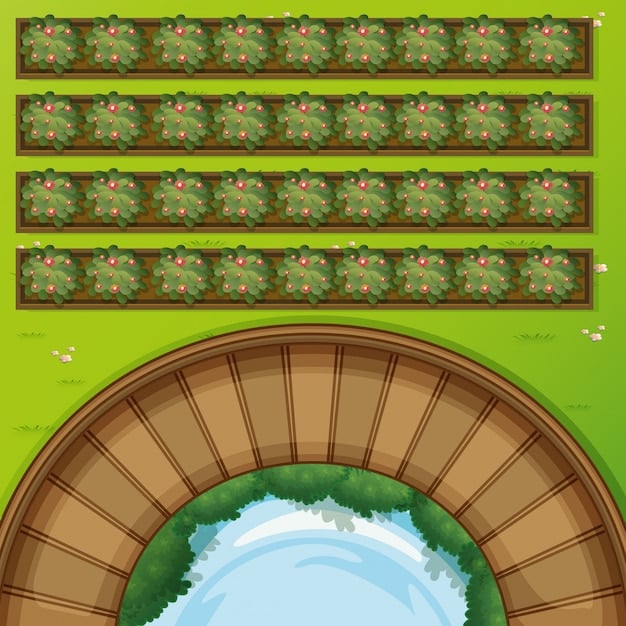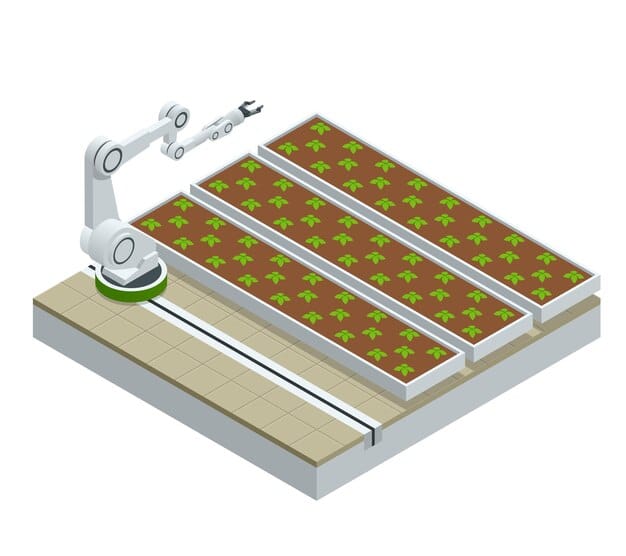Minecraft Redstone Guide: Build Your Automated Farm in 7 Days

Crafting a fully automated farm in Minecraft within seven days using Redstone is achievable by understanding essential components, planning the farm layout for efficiency, and implementing Redstone circuitry for automation.
Dive into the world of Minecraft automation with our comprehensive Minecraft Redstone Guide: Build a Fully Automated Farm in 7 Days. Learn how to harness the power of Redstone to create efficient and self-sustaining farms.
Understanding Redstone Basics for Farm Automation
Embarking on your journey to automate your Minecraft farm requires a solid grasp of Redstone. This section will cover the fundamental components and concepts you’ll need to succeed.
Essential Redstone Components
Redstone is the key to automation in Minecraft. Understanding what each component does will allow you to build any farm you can imagine.
- Redstone Dust: Used as wiring to transmit power between components.
- Redstone Repeaters: Amplifies and delays a Redstone signal, allowing it to travel longer distances.
- Redstone Comparators: Compares the signal strength of two inputs, useful for detecting fullness of storage containers.
- Redstone Pistons and Sticky Pistons: Used for pushing and pulling blocks, essential for harvesting crops.

Understanding Redstone Logic Gates
Logic gates are like the building blocks of complex circuits. Learning them now will pay off in the long run.
- AND Gate: Outputs a signal only if all inputs are powered.
- OR Gate: Outputs a signal if any input is powered.
- NOT Gate: Inverts the signal; outputs a signal only if the input is not powered.
- XOR Gate: Outputs a signal if the inputs are different.
With a firm grasp of Redstone components and logic gates, you’re well-prepared to start planning and building your automated farm. Next, we’ll dive into planning the layout of your farm to maximize efficiency.
Planning Your Automated Farm Layout for Efficiency
Efficient farm design is crucial for maximizing yields and minimizing manual labor. Think about the location, the type, and the system.
Choosing the Right Location
Consider the biome and available resources when deciding where to build. Location is prime if you are looking for ease and speed of material gathering.
- Accessibility: Ensure easy access to your base and storage areas.
- Biome: Select a biome suitable for your chosen crops or animals.
- Space: Plan for future expansion and scalability.
Selecting the Type of Farm
Different farms have different yields and resource requirements. Decide what you are looking to sustain before you build anything.
- Crop Farms: Wheat, carrots, potatoes, beetroot, etc.
- Animal Farms: Chickens (for eggs and feathers), cows (for milk and leather), sheep (for wool).
- Tree Farms: For wood, which is an universally needed resource.

Effective farm layout is pivotal for optimizing resource yields with minimal effort. With careful planning, your automated farm will operate at peak efficiency, providing you with a steady supply of valuable resources. Next up is the implementation of Redstone circuitry for automation.
Implementing Redstone Circuitry for Automation
Now comes the fun part: integrating Redstone circuits to automate harvesting, planting, and collection. This is where your automation dream becomes a reality.
Automated Harvesting Systems
Harvesting is the most labor intensive part of regular farming. Why not let Redstone do the work and save your endurance?
Use pistons to push water over crops, collecting them in a stream leading to a collection point. Use observers to detect when crops are fully grown and trigger the harvesting mechanism.
Automated Planting Systems
If harvesting is hands off, why not planting? Cut your farming time even more with this step forward in efficiency.
Use dispensers filled with seeds or saplings to automatically plant crops after harvesting. Use a Redstone clock circuit to control the timing of planting.
Automated Collection Systems
With resources harvested and replanted automatically, one thing remains, the collection. Here is what to do:
Use hoppers and minecarts with hoppers to collect items and transport them to a centralized storage system. Try using Redstone comparators to detect when storage containers are full and stop the farm temporarily.
With Redstone circuitry expertly integrated into your automated farm, you’ve unlocked the true potential of Minecraft automation. This section will cover maintenance and optimization tips to keep your farm running smoothly for continuous resource generation.
Maintenance and Optimization Tips
Like any machine, your farm needs regular maintenance to ensure optimal performance. Here are some helpful tips.
Regular Checks and Repairs
Regular inspections can stop failures before they start. Make sure to set a schedule for consistent checks to keep your farm running smoother for longer!
Check Redstone wiring for any disconnections or power loss. Replace broken pistons or dispensers. Clear any blockages in water streams or collection systems.
Optimizing Crop Growth
Speed up your growth with these tips for optimization of your outputs.
Use bone meal to accelerate crop growth. Provide adequate lighting to crops to maximize growth rates. Optimize water placement for efficient hydration.
Expanding Your Farm
Keep your farm adaptable to your needs and the ever increasing hunger for resources.
Add more layers or modules to increase production capacity. Automate additional processes, such as sorting and smelting. Experiment with different farm designs to find what works best for you.
By following these maintenance and optimization tips, you can ensure your automated farm remains a reliable and efficient source of resources for all your Minecraft adventures. Next, we’ll address common issues and troubleshooting techniques to keep your farm running smoothly.
Troubleshooting Common Issues
Even the best-designed farms can encounter problems. Here’s how to diagnose and fix them.
Redstone Circuit Failures
Redstone circuits can be complicated. But a simple error can halt a large operation! Here is how to trouble shoot effectively.
Use a multimeter to trace the signal path and identify any breaks. Check connections and component settings. Ensure that all components are powered correctly.
Crop Growth Problems
Sometimes you are not getting the crop output that you deserve. Here are some things that might get in the way.
Verify that crops have enough light and water. Check the surrounding blocks for obstructions. Ensure that the biome is suitable for the crops being grown.
Collection System Malfunctions
Are your crops not finding their way to the storage? Then there must be something going wrong in the collection system. Here are the main things to check:
Inspect hoppers and minecarts for blockages. Make sure the storage containers are not full. Confirm that the items are being transported correctly to the intended destination.
By following these troubleshooting steps, you can quickly identify and resolve common issues, keeping your automated farm running smoothly and efficiently. Understanding these tricks will let you quickly resolve common obstacles. Lastly, we’ll look at some advanced Redstone techniques to further enhance your farm’s capabilities.
Advanced Redstone Techniques for Enhanced Automation
Ready to take your farm to the next level? These advanced techniques will help you push the boundaries of automation.
Using Redstone Clocks for Precise Timing
Timing can be very important with resource gathering. Setting the right timing can give you a significant step up in efficiency and speed.
Use a Redstone clock circuit to control the timing of various farm processes, such as planting and harvesting. Experiment with different clock speeds to optimize performance. Try using variable timers for processes that require dynamic timing.
Integrating Item Sorting Systems
If you farm a lot of different types of resources, it is important to be able to keep them organized and separate. Item sorters make this a hand-free process.
Use Redstone comparators and hoppers to create an item sorting system that automatically separates different types of crops or resources. Filter items into dedicated storage containers for easy access. Try using overflow protection to prevent items from clogging the system.
Implementing Self-Repairing Mechanisms
Keep your systems alive by having them repair themselves! This is the peak of automation technology.
Use Redstone and pistons to create self-repairing mechanisms that automatically replace broken blocks or components. Monitor the health of your farm and trigger repairs as needed. Ensure that you have a sufficient supply of spare parts stored nearby.
These advanced Redstone techniques can elevate your automated farm to new levels of sophistication and efficiency, making it a truly remarkable feat of engineering. Now, let’s recap the steps we’ve discussed and ensure you’re well-prepared to embark on your 7-day automated farm journey.
| Key Point | Brief Description |
|---|---|
| 💡 Redstone Basics | Understand components like dust, repeaters, and logic gates. |
| 🌱 Efficient Layout | Choose the right biome, location, and farm type for optimal yield. |
| ⚙️ Automation Systems | Implement Redstone for harvesting, planting, and collection. |
| 🔧 Maintenance | Regular checks, crop growth optimization, and farm expansion. |
FAQ
▼
Essential components include Redstone dust for wiring, repeaters for signal amplification, comparators for detecting fullness, and pistons for harvesting. Understanding these elements is crucial for automation.
▼
Consider accessibility to your base, the biome suitability for your chosen crops or animals, and plan for future expansion. Ensure ample space to maximize farm efficiency and scalability.
▼
You can automate crop farms (wheat, carrots, potatoes), animal farms (chickens, cows, sheep), and tree farms. Selecting the appropriate type depends on your required resources and infrastructure.
▼
Regular inspections are essential. Check Redstone wiring, replace broken components, and clear blockages in water streams or collection systems. A consistent maintenance schedule will ensure optimal performance.
▼
Employ Redstone clocks for precise timing, integrate item sorting systems to manage resources efficiently, and implement self-repairing mechanisms for long-term stability. These strategies optimize farm capabilities.
Conclusion
Building a fully automated Minecraft Redstone Guide: Build a Fully Automated Farm in 7 Days is an ambitious yet achievable goal. By mastering Redstone basics, planning carefully, and troubleshooting effectively, you can create a self-sustaining farm that provides a steady supply of resources for all your Minecraft adventures. Now get out there and build!





